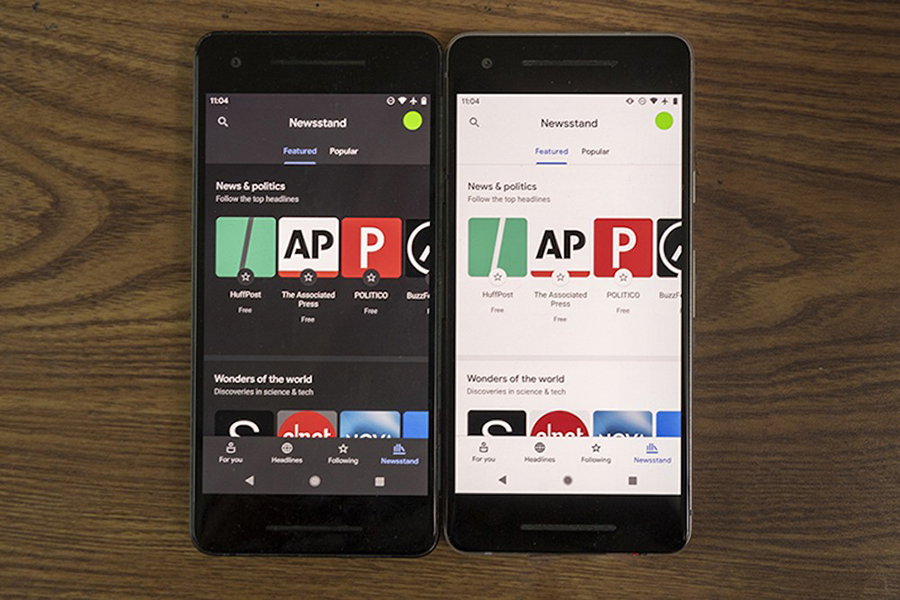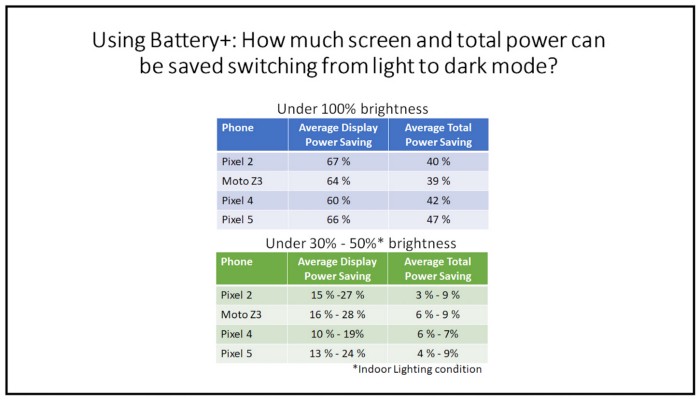Shedding light on dark mode to save energy

Increasing energy conservation to mitigate the effects of climate change is a grand strategy with lofty goals that depends on continuous improvements to the energy efficiency of every powered device and activity. That includes smartphones, and the batteries that energize them.
The smartphone industry rushed to adopt the OLED (organic light-emitting diode) display around 2017 because it’s thinner, more flexible, and more power-efficient than its predecessor, LCD (liquid-crystal display). By getting rid of the backlight in LCD, and directly emitting light by each pixel, an OLED display draws much less power when displaying darker-colored images.
This transition gave rise to the popularity of dark mode, or dark-themed UI (user interface) design. In addition to built-in support on iOS and Android, many apps on both platforms natively support dark mode, where darker-colored pixels use less power than brighter alternatives, saving battery life with OLED screens. Review blogs quickly popped up, headlined with such catchy, breathless titles as, “Dark mode can save massive amount of battery.”
Not so fast. We investigated six popular Android apps — Google Maps, Google News, Google Phone, Google Calendar, YouTube, and Calculator — each with more than a billion downloads, for four generations of phones with OLED screens released in 2017, 2018, 2019 and 2020. Our team examined 60 seconds of usage of these apps, in dark and light mode, for the Google Pixel 2, 4 and 5 and Motorola Moto Z3 models. We believe the results may have similar implications for Apple iOS phones.
Our findings contradicted the popular wisdom: Under normal usage (indoor, with auto-brightness turned on), switching to dark mode saves on average 3 percent to 9 percent of total phone power — a percentage that hardly qualifies as “massive,” and certainly is not significant enough to make the necessary kinds of inroads in energy savings.

The key insight for such a disappointingly small power saving is that switching to dark mode (i.e., using dark-themed color design) is only one “knob” involved in controlling the OLED display power draw. The other important knob is the brightness level. Our study showed that lowering the brightness level reduces the OLED display power draw exponentially — for example, decreasing the brightness level from 100 percent to 50 percent reduces the OLED power draw by about 10x, independent of the frame content being dark-themed or not.
Thus, at a low brightness level, because the OLED power draw in light mode already is a lot smaller to begin with, the saving from switching to dark mode at that point also is a lot smaller, so the percentage saving on the total phone power draw is a lot less!
Turns out, when we conducted our study, the tools were not yet available to accurately measure the pixel power draw of OLED screens, which is a function of the color displayed by the pixel. Pre-measuring the pixel power draw for all possible colors — 16 million of them in total — is simply impractical.
In response, we developed the first OLED profiling tool that allows software developers to accurately and instantaneously quantify the OLED power draw involved in displaying any given frame on a smartphone screen, which consists of millions of pixels, each displaying a possibly different color. The tool, called a Per-Frame OLED Power Profiler, lets developers factor energy savings into their app designs.
Prior to our tool, measurements of battery saving due to dark mode were essentially “brute-force” — they treated the phone as a black box, and had to observe the entire phone battery level drop when switching to dark mode for a very long duration (e.g., until the battery is drained). Our innovation is to isolate the amount of battery drain uniquely associated with the OLED display, and quantify it at the granularity of displaying a single frame.
The underpinning of this novel profiling tool — what makes it all possible — is a new invention: an accurate OLED power-modeling methodology. We have filed for a patent (now pending) on this tool through Purdue University’s Office of Technology Commercialization.

The regrettably low battery saving of dark mode under normal usage is not the end of the story. There are some scenarios in which dark mode still can make a big difference today — for example, in outdoor settings, where Android’s auto-brightness feature easily cranks up the bright level to 100 percent, the power saving can be as high as 39 percent to 47 percent.
For such scenarios, app developers can use our OLED power-draw tool to optimize the OLED screen power draw by their apps by experimenting with alternative app UI designs. This can lengthen the life of the lithium battery powering the smartphone even further.
Longer battery life means less recharging, and therefore less frequent draws on electrical power. It also means fewer replacement batteries for smartphones, reducing energy consumption and emissions in mining and processing lithium — one more contributor to our planet’s all-hands-on-deck response to climate-altering human activity.
